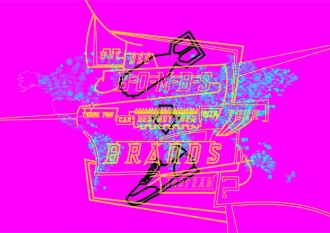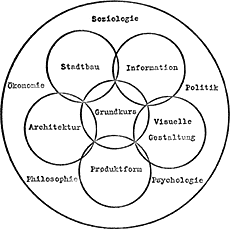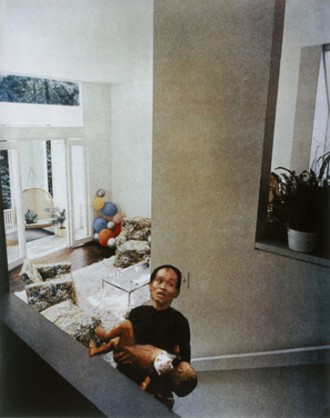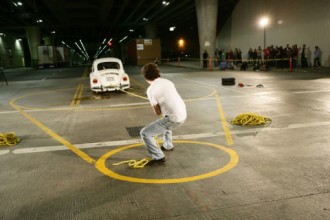Morality and the pursuit of authenticity have been of perennial concern to the practice of form-giving — specifically design. To design is to mark out; it involves separating out what is from what should be. Inherent in this process is the establishment of a need. Victor Papanek, for example, posits that “design is the conscious effort to impose meaningful order.”[1] Whether this is the ordering of shapes and lines on a sheet of paper or the gathering of materials to create a tool, the designer engages in a quasi-rational process of selecting a goal and a means of achieving that goal. In this light, design implies a progressive movement toward what should be.
This understanding of design corresponds with the common definition of critique as discernment or the evaluation of what is and what is not. Implied in the logic of critique is the finding and presentation of truth. Critical Theory from the Frankfurt School tradition has been described as an endeavour “to liberate human beings from the circumstances that enslave them.”[2] It is predicated on a notion that the world is in ruins, that humans are in chains, and that there are universal concepts of human dignity and welfare. Change is made through rigorous critique of these conditions.
If design and critique share a similar process by which what is is separated from what is not or what should be they may also share similar fates. More recent work in the area of critical design has shifted from a focus on negation to a focus on the aesthetics of relation and participation. Bruno Latour’s work in actor-network theory and Jacques Ranciere’s concept of the distribution of the sensible can aid in understanding this shift: Latour’s focus on socio-technical configurations (which involve science and technologies through history, philosophy and sociology) is useful because of design’s involvement with communication, information and technical innovation. Ranciere’s analysis of the image and its use in progressive politics is useful because of the importance of visuality and experience in design. Interestingly, both Latour and Ranciere assess the limits of criticality. The question follows: how can these limits be applied to criticality in design?
[click any image for caption and gallery]
Within design, the critical stance has been expressed in at least two different ways. The first way is closely aligned with the tenets of Critical Theory. Emancipation through a critique of mass media is seen as the primary strategy. It tends to presuppose a duped citizen or consumer that is in need of a critical distance between images and reality. Examples in graphic design include the work of Jan Van Toorn and Jonathan Barnbrook. These designers work to unveil the mechanisms of cultural hegemony by which ideology is maintained. Van Toorn advocates for a visual journalism that disrupts popular media images through the juxtaposition of contradictory images or seemingly incongruent text. Similarly, Barnbrook uses generic iconography and ubiquitous corporate logos along with provocative texts to call attention to the imperialist tendencies of corporate media.
The second way treats critique as a fundamental aspect of the design process. Clive Dilnot, echoing the impulse of design posited by Papanek, states that the critical move is an inseparable part of design in that it constitutes the act of deciding what is and what should be. To discern what is lacking in a given state of affairs is already to decide what could be and this informs the direction of the design activity. A key example can be found in the Ulm School of Design, an unofficial successor to the Bauhaus, which made it a founding principle to consider design a moral act. First among the criteria for any endeavour was the assessment of how the project would benefit humanity. Human need was analyzed and incorporated into the entire process of concept generation, form-making and production. The structure of the school, framed by Otl Aicher, Max Bill and others, instills a constant evaluation of the design activity through humanist terms (such as, sociology, economy, politics, psychology, philosophy).
The incorporation of critical thought and humanistic goals into design pedagogy marks a defining moment in the development of the design field. The impulse has lost out, however, in the age of designed obsolescence, conspicuous consumption and Moore’s law of computational power, which is characterized by rapacious production and disposal of designed objects. In this climate, design has been and in many ways continues to be, the purveyor of perceived difference (between products and brands) and the creator of new needs in the service of a growth economy that requires constant renewal. Glen Hill, citing Gianni Vattimo, suggests that “in a consumer society continual renewal (of clothes, tools, buildings) is already required physiologically for the system simply to survive. What is new is not in the least ‘revolutionary’ or subversive: it is what allows things to stay the same.”[3] Needs in this context become effects of the system and thus help reproduce the system.
This reassessment of needs and where and what design is oriented towards represents a breakdown in the conventional logic of design that mirrors a recent trend in critical thought. Jacques Ranciere suggests that the critical enterprise has experienced a reversal effect in that the logic embodied in critique and anti-critique is unproductive in a progressive politics. Both modes are based on the logic of unveiling a hidden truth which assumes ignorance on the part of the viewer and relies on the guilt of inaction to produce its effects. Ranciere’s analysis changes the way we understand the work of certain designers. Van Toorn, for example, uses collage as a principal means of deconstructing images and concepts carried out in the popular media. Adbusters’ culture-jamming strategy also often uses collage. Both function very much in the mode described by Ranciere: images collide in order to portray a before and after, or an illusion and truth. This kind of “critical” collage work leaves the traces of the act of assembling images and so further hints at the constructed nature of media messages. According to Ranciere, however, it exemplifies the way that critical art can be mired in an endless loop of unveiling and guilt. Ranciere uses the example of Martha Rosler’s “Balloons,” part of the “House Beautiful: Bringing the War Home” series (1967-72), as an illustration of unmasking a truth (in this case, the contradiction between an American way of life and its foreign policy) and its attendant effect of producing pathos and guilt for our inaction in the face knowing about such injustices.
In its stead, Ranciere advocates for a kind of critique that looks beyond the reality/illusion and action/inaction dichotomies. He states that “at the heart of this approach is the attempt to uncouple the link between the emancipatory logic of capacity and the critical logic of collective inveiglement.”[4] This bears an echo of Bruno Latour’s argument for raising the ethnographic informant’s account to the same level of importance as the sociologist’s. Rather than treat them as dupes formed by fetishes (Latour) or the imbeciles trapped in Plato’s Cave (Ranciere), the actors, both networked and political, must figure as relational agents capable of effecting change. It is this stress on the relational structure of aesthetics or networks of actors that is at the core of the alternatives to traditional critical theory offered by both Latour and Ranciere.
One of the fundamental ways to help understand the current weakness in critical thought, as posited by Latour, is working with a distinction between “matters of fact” and “matters of concern.” Facts no longer hold the privileged position of absolute reality. A plurality of actors has rendered facts as concerns that at times become more stabilized or more controversial. Latour takes up a strategy of assemblage as a way out of the bankruptcy of the critical enterprise. Borrowing from Gilles Deleuze and Felix Guattari, Latour describes networks of actors as assemblages and underscores the importance of associations between non-humans and humans. Rather than creating a collision of representations in order to perform an unveiling of an illusion, as Ranciere has shown in examples of collage, assemblages highlight the careful piecing together of heterogeneous components to mark their connectedness. For example, “The Beetle Trilogy,” (2002-2005) by Damian Ortega, works through three relationships to an object. The Volkwagen Beetle, in Ortega’s series, is disassembled, fought against and buried. Each action highlights the relationship between the technological object and the context of its existence. In one phase the car is dismantled and presented as an exploded-view. While in two others, the artist engages in a tug-of-war with the car and performs a ritual burial of the car with a community of helpers.
The gathering of relations between human and non-human actors represents a relational turn that is also seen in the work of Ranciere. While Ranciere wishes to point out the relational character of how aesthetic experience is distributed, Latour points out how various entities work together to produce stable networks. Latour’s project is committed to creating richer accounts of the networks of actors that configure human lives, technologies and environments. This amounts to a descriptive act. On the other hand, Ranciere’s position advocates a new political involvement that does away with a critique of the machine and instead focuses on how image and action are intertwined in a “dissensus” or distribution of aesthetic experience. Dissensus, he states, “is an organization of the sensible where there is neither a reality concealed behind appearances nor a single regime of presentation and interpretation of the given imposing its obviousness on all. It means that every situation can be cracked open from the inside, reconfigured in a different regime of perception and signification.”[5]
Finally, dissensus echos another aspect of Latour’s logic — the notion of style. A much scorned term in the politics of authentic and responsible design, style evokes the idea that the surface is emotional, fleeting, superfluous and, most importantly, wasteful, in the sense that it depletes valuable resources in the pursuit of (brand) difference. But style can also be taken up as the particular manner in which something is described or assembled and thereby resists a temptation to promote a totalizing view. Similar to cognitive styles, research approaches or styles of resistances, the notion of style is pluralistic and allows for multiple arrangements and configurations to be added to the pile. This is in contrast to the iconoclastic impulse of critical thought which seeks to destroy past orthodoxies and erect new ones.
Within design this relational turn can be summed up as the fact that design keeps designing. For Tony Fry, this notion seeks to highlight the way that objects are designed to affect human behaviour and frame human action which ultimately frames further design activity. Similarly, Anne Marie Willis’ notion of “ontological designing” evinces this trend towards relational thinking when she suggests that design influences the act of designing. As Willis explains, “here is ontological designing – based upon a circularity, in which knowledge comes to be inscribed by being with the ‘designing-being’ of a tool, this in turn modifying (designing) the being of the tool-user.”[6] Fry expands this by stating that everyone is a designer (in the sense that they plan and carry out actions) but that everyone is also designed (in the sense that they are affected by the various affordances of designed objects in their use and in their environment).
Similarly, Latour asks us to look at an object as a project, by which he means that objects are gatherings of multiple actors and themselves participate in larger networks of actors. Similar to Fry’s contention that design keeps designing, Latour reminds us that objects mediate human intentions and act on the behalf of humans to the point where a network of actors (human and non-human) act upon human actors. Latour looks to styling or re-styling as a way of capturing an aspect of design that repairs and rearranges rather than creates. Latour suggests that the word revolution be replaced with the word design: where revolution embodies “detachment, modernization, progress and mastery,” design embodies “attachment, precaution, entanglement, dependence and care.”[7]
As the usefulness of critique is brought into question, the usefulness of design is also drawn into question by virtue of their compatible logics. By comparing the assessments of critique by Latour and Ranciere we can see that both theorists share a similar logic of flatness, interconnectedness and agency. While Latour removes the opposition of real and illusion by emphasizing the assembly of things (images, objects, people, etc.) through “matters of concern,” Ranciere emphasizes struggle and the friction of multiple sites of representation and action in the “dissensus.” Design, through these conceptions, can find a way of stepping away from devising teleological concepts, pursuing universalist, transcendent or essential forms, and resorting to hierarchical structures of power. The appeal to contingent processes and a relational logic, as espoused by Latour and Ranciere, is also seen in the work of Fry and Willis. This shift points to a mode of designing that steers away from notions of uncontrolled growth and novelty and towards small steps and thoughtful reconfigurations.
1. Papanek, Victor. Design for the Real World : Human Ecology and Social Change. 2nd ed., completely rev. Chicago Ill.: Academy Chicago, 1985. – page 6
2. Horkheimer, Max. Critical Theory : Selected Essays. New York: Continuum Pub. Corp., 1982. – page 244
3. Hill, Glen. “Design Without Causality: Heidegger’s Impossible Challenge for Ecologically Sustainable Architecture.” University of Technology Sydney, 2007.
4. Rancière, Jacques. The Emancipated Spectator. London: Verso, 2009. – page 48
5. Rancière, Jacques. The Emancipated Spectator. London: Verso, 2009. – page 48
6. Willis, Anne-Marie. “Ontological Designing.” Design Philosophy Papers 2 (2006). http://www.desphilosophy.com/dpp/home.html. 2 (2006).
7. Latour, Bruno. “A Cautious Prometheus? A Few Steps Toward a Philosophy of Design (with Special Attention to Peter Sloterdijk).” Falmouth, Cornwall UK, 2008. http://www.bruno-latour.fr/sites/default/files/112-DESIGN-CORNWALL-GB.pdf.
An earlier version of this paper was presented at the UAAC 2011 conference, Design as a Wicked Problem, Ottawa, 2011.







